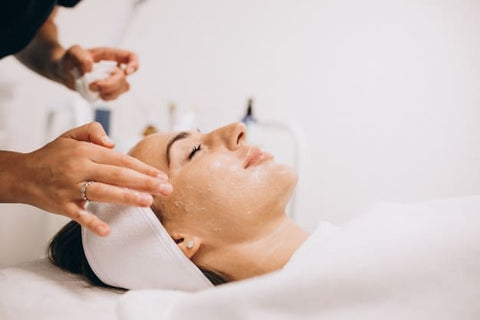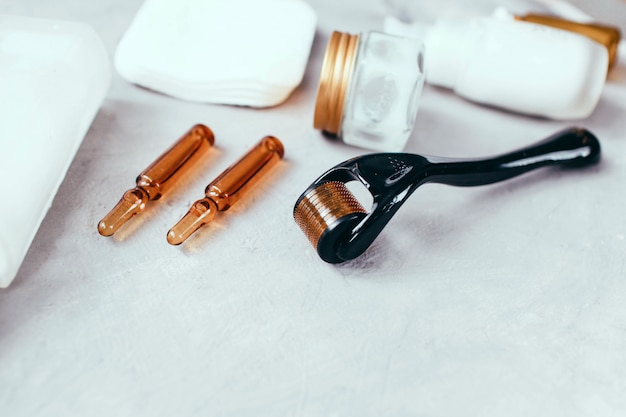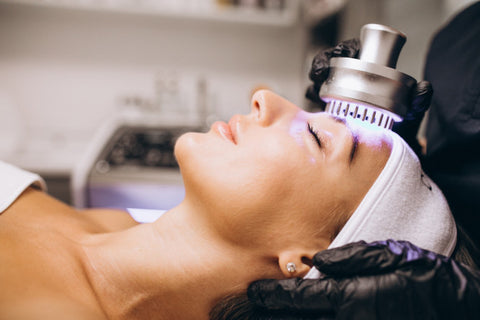Hyperpigmentation -What Is It And Are There Any Treatments?
AUTHOR - DR. DAVID JACK

In the last 12 years since I started my skin clinic, one of the most common skin conditions I see is that of hyperpigmentation of one form or another. It’s an issue that affects almost everyone’s skin in one form or another, regardless of gender or ethnicity. Although age related changes occurring mostly due to sun damage over the years is by far the most common cause of pigmentation changes in the skin, a number of different factors can cause forms of hyperpigmentation.

What Are The Different Types Of Hyperpigmentation?
Hyperpigmentation is a very general term that describes a number of different situations where there is excessive production of the natural pigment known as melanin by the skin (not all of these would be described as ‘conditions’ as some are part of normal ageing in the skin). Melanin has a brown colour and is responsible for protecting the deep layers of the skin against damaging light rays from the sun known as ultraviolet radiation (UV or UVR). Because of its colour, it is what gives our skin its overall tone.
A complete or partial absence of melanin is seen in people with a condition called albanism, and patchy loss can be seen in people suffering from vitiligo, where there is autoimmune destruction of the pigment-producing melanocyte cells.
When our skin is exposed to UV light from the sun, the melanocyte cells respond by producing more melanin and making the skin darker. Melanocyte cells are actually part of our immune system and function is similar ways to other immune type cells, i.e. they can increase their activity and divide in response to this external stimulus (when you think of this UV as a ‘threat’ to the skin, like infections or injuries, you can understand the similarities of how they behave). They also respond to certain hormones in the body such as oestrogen, progesterone, cortisol, and thyroid hormones.
Pigmentation changes can, therefore, happen because of a number of different issues.
The most common type of hyperpigmentation issues seen in clinic are:
- Sun damage hyperpigmentation (sunspots or solar lentigines): Over time as our skin is exposed to UV and even blue light from the sun and other sources, the melanocyte cells start to become damaged themselves, causing them to be less able to regulate the production of melanin. As a result, in certain areas of the skin overproduce melanin create distinct pigmented patches on the skin. These are usually at the level of the epidermis of the skin (the most superficial layer). These are commonly found on the face, hands and décolletage and are often referred to as age spots or sun spots. Solar lentigines are found in all skin types.
- Post-inflammatory pigmentation (PIH): Melanocytes are similar to immune cells, i.e. they react and become more active in response to inflammation in the skin. In some people, this happens more than others (particularly darker skin types) and areas of pigmentation can be left long term after any type of inflammation in the skin. This often affects acne and scars, as well as surgical scars, and can happen after treatments such as laser, particularly in darker skin types.
- Melasma: Melasma or chloasma is a condition where brown or greyish patches of pigmentation develop often as a result of internal body triggers, such as hormone changes such as pregnancy and thyroid conditions, and the oral contraceptive pill. indeed, melasma is sometimes described as the ‘mask of pregnancy’. Melasma is often worsened by sun exposure in the summer and improves in wintertime. Thyroid disorders and other hormone imbalances such as Addison’s disease (associated with high cortisol levels) can also cause pigmentation issues. Treatment of melasma may differ from that of other forms of hyperpigmentation.
How Can You Treat Hyperpigmentation?
As with most skin issues, it’s always worth having a chat to your skin specialist or dermatologist. In order for us to really tailor treatments to your particular case, an in-person book an appointment on assessment is usually best so we can take a close look at your skin and advise based on your particular issue, medical history, and skin examination. Treatment will also depend on your individual skin phototype, i.e. whether you are a light-skinned or darker-skinned patient, as darker skinned patients tend to require less aggressive treatment at first.
Successful treatment of hyperpigmentation depends on the underlying cause and diagnosis and your individual skin type or skin tone. With hormone-related conditions such as melasma, your doctor may perform some investigations and tests to identify if there is an underlying issue that needs to be treated medically.
With medical conditions excluded, I usually like to think of hyperpigmentation treatment like a stepladder, starting with the most simple solutions first, testing if they work, and if they don’t, gradually going up the treatment stepladder to more advanced options.
CAN I TREAT HYPERPIGMENTATION AT HOME?
The good news is that many forms of hyperpigmentation can be effectively treated at home, starting with home skincare products for hyperpigmentation and home treatments. In the next section, I will outline how to treat hyperpigmentation both at home and with in-clinic treatments. Generally speaking, hyperpigmentation treatments take several weeks of treatment (or even months) to work.
A STEPLADDER APPROACH TO TREATMENTS FOR HYPERPIGMENTATION:
Step 1: Home skincare products
The topical home use products that have the most evidence for use in the treatment of hyperpigmentation include several different groups of skincare ingredients. Most of these work to block melanin production by the melanocyte cells in the skin by interrupting the processes the cells use to make melanin or transfer it to other skin cells. Although topical skincare can have noticeable effects after a month or so, more often than not 3 months or more of consistent use is needed to properly test effectiveness.
After the 3-6 month mark if you are not noticing any difference I’d recommend trying something different or stronger.
These include:
- Daily broad-spectrum sunscreen - sunscreen is the single most important skincare product that you should be using to prevent overproduction of melanin in relation to UV exposure. Indeed, excessive production of melanin mostly relates to excessive sun exposure. Look for a high sun protection factor (SPF) number, and a broad spectrum filter. SPF should be applied to sun-exposed areas daily and reapplied regularly. Example ingredients in sunscreen include chemical filters, such as homosalate, and mineral filters such as titanium dioxide and zinc oxide - check out my other blog post on sunscreens here.
-
Vitamin C - vitamin C works by inhibiting a copper-based enzyme in pigment cells (melanocytes) called tyrosinase that is used in melanocytes to make melanin. Clinical studies have shown that vitamin C together with vitamin E also has strong antioxidant actions that can help reduce and protect the cells of the skin against future UV damage.
-
Retinoids (vitamin A) - retinoids work in a number of ways to reduce the production of melanin and also by increasing the effectiveness of other skincare products such as kojic acid, hydroquinone, and azelaic acid. Retinoids come in various strengths so you should speak to your skincare specialist to help decide which one is best for you. Gentle retinoids such as retinyl palmitate are great for people that are concerned about redness or peeling with stronger retinoids. Prescription retinoids such as tretinoin are available if over the counter retinoids have not been successful.
-
Alpha hydroxy acids (AHAs) - such as glycolic acid, mandelic acid, lactic acid, and citric acid all have beneficial actions on existing pigmentation and can reduce melanin production with repeated use. They also have exfoliating effects so they can help improve the penetration of other skincare products into the skin.
-
Kojic acid - produced by certain fungi and by fermentation of soy sauce and rice wine, Kojic acid can be used in skincare to reduce pigmentation and is one of the few ingredients that has clinically proven benefits when treating pregnancy-related melasma. Kojic acid for hyperpigmentation works in a similar way to vitamin C by blocking the enzyme tyrosinase and halting the production of melanin by skin melanocytes. In skincare, it is usually used at concentrations between 1-4% and has an anti-bacterial and anti-fungal effect.
-
Azelaic acid - Azelaic acid is what's known as a dicarboxylic acid. It is extracted from grains such as wheat, barley, and rye. Azelaic acid works in a similar way to vitamin C and Kojic acid in that it inhibits tyrosinase and reduces the production of melanin. Azelaic acid is also effective in treating mild to moderate rosacea and also reducing acne.
-
Ferulic acid - Ferulic acid also inhibits the enzyme tyrosinase, so in itself can reduce pigmentation. It has been shown also to increase the effects of vitamin C and E. Ferulic acid can also increase the anti-pigmentation effect of other ingredients including niacinamide (Vitamin B3). Similar to other molecules in this list it can absorb UV light and prevent damage to melanocytes and other skin cells.
-
Alpha-arbutin and beta-arbutin - these molecules are derived from hydroquinone, which is available in prescription only pigmentation treatments in the UK. Hydroquinone, alpha, and beta-arbutin all work by inhibiting the enzyme tyrosinase.
-
Hydroquinone - considered by many to be the Gold standard treatment for pigmentation, Hydroquinone is a dihydric phenol that blocks the production of pigmentation by inhibiting tyrosinase. It does this in a slightly different way than its arbutin derivatives so it is particularly potent. It is believed, however, to have potential side effects that have limited its use to being prescription only. Concentrations of between 2 and 4% are considered safe for use in topical skincare.
-
N-acetylglucosamine (NAG) - NAG works by blocking the production of tyrosinase in pigment cells and in turn reduces melanin production. It tends to work best in combination with Niacinamide (Vitamin B3)
-
Vitamin B3 (Niacinamide) - a derivative of Vitamin B3, niacinamide has both anti-inflammatory effects and also blocks the transfer of pigment granules called melanosomes from melanocytes (pigment cells) to the rest of the skin.
- Botanical and Plant extracts - a number of different plant extracts have been shown to be effective in the reduction of pigmentation. Most of these are believed to work in similar ways to the ingredients listed above with both antioxidant and anti-inflammatory properties. These include Pycnogenol (Maritime pine extract), Green tea extract, Grape Seed Extract, Marine Algae Extract, Aloesin, Coffeeberry Extract, Mulberry Extract Licorice extract (Glabridin), Boswellia extract and Umbelliferone extract. There are others but this list could go on forever!
Step 2: At home treatments
Once you’ve exhausted whatever skincare you have chosen (and given it at least 3 months OF consistent use) or if you feel its starting to work but want to do something slightly stronger at home, I’d maybe consider doing a home treatment such as peel or mask every so often.
Home light chemical peels generally work by a combination of exfoliating the skin (to improve penetration of any products by reducing the waterproof top layer of the skin and ‘acid mantle’) and can have pigment reduction benefits.
Alongside home peels, many new home treatments have come to market, such as home LED masks. These might help over time but certainly more evidence is needed before we have a good idea about their usefulness.
With LED, the higher the number/concentration of LED bulbs, the more effective the treatment. The results are generally not permanent so the use of LED really does require commitment (as often as daily use!).
Most home peels generally use higher concentrations of active ingredients than regular skincare but lower than in clinic treatments. A vast number of options are available for home peeling - from AHAs to retinoids to botanical peels.
Our favorites include:
- Kojic acid
- Glycolic acid
- Vitamin C
- Retinol
- Ferulic acid
- Arutin
- Mandelic acid
Step 3: Prescription skincare
When home skincare and gentle home peels haven't been of any success, or you are looking for something a bit more powerful, it’s time to start talking to a professional. Most good skin clinics and dermatologists will have a wealth of experience in treating pigmentation issues. Whoever you decide to see should take a full medical history and assess your skin using a variety of methods. Some clinics use tools like Wood’s lamps and dermatoscopes to look at the skin, although this isn’t always necessary. From there, they should make a detailed bespoke plan for your treatments.
Often a starting point will be prescribing skincare products to use at home for a few months and a full regime of the morning to night skincare will be given.
At my clinic we will often try a period of strong retinol, such as tretinoin, plus introducing a hydroquinone based product for about 3-6 months. Alongside this, we might suggest doing some light chemical peels or other gentle treatments.
Step 4: Gentle in-clinic treatments: Superficial chemical peels, Dermaroller, Injectables

If prescription skincare isn't enough after a few months, or your particular case warrants more intense treatments then you might benefit from some in-clinic treatments. The most easily accessible of these include treatments such as AHA peels at higher strengths. AHAs including mandelic, lactic, and glycolic acid are often very beneficial at intermediate strengths when used repeatedly on the pigmentation of most types. AHA peels will usually be done once per month for 4-6 months for the best results. They can be combined with other treatments and prescription skincare.
Certain types of deeper pigmentation may also benefit from treatments such as microneedling - a number of different techniques are available but most use the same principle. There is a small risk of PIH in some skin types so your therapist will advise on this. It is important for darker skin types to check that the clinic has experience in treating darker skin. Injectables such as mesotherapy can sometimes help with superficial pigmentation. Mesotherapy essentially involves the very superficial injection of blends of vitamins and skin-boosting ingredients such as hyaluronic acid into the deeper layers of the epidermis and upper dermis layer. When done on a regular basis, this can sometimes be helpful in treating certain cases.
Step 5: IPL, Laser and deeper chemical peels (in the clinic)

When gentle treatments don’t quite crack it, fear not! There are still some options that may help. These should only be done by experienced professionals and require careful consideration depending on your skin type.
The risk of any more aggressive treatments, particularly in darker skin types is that they produce inflammation and a risk of causing post-inflammatory hyperpigmentation (PIH) i.e. worsening the situation.
-
Laser - Laser therapy utilizes particular wavelengths of light to target pigment in the skin and cause it to heat and break apart. There are many different types of lasers available but these should only be used by people who have extensive experience in their use. Always check with your practitioner that they have dealt with your skin type and issue before your treatment.
-
IPL - Intense pulsed light is similar to laser but uses a number of different wavelengths of light. Again, this should only be done by an experienced professional
-
Medium chemical peel to deep chemical peel - These uses ingredients such as trichloroacetic acid and low percentages of the chemical phenol, as well as high levels of some of the ingredients used in the weaker in-clinic peels. They should again only be used under the supervision of experienced professionals and care needs to be taken in darker skin types.
Step 6: Fractional laser, skin resurfacing (advanced in clinic treatments) and off-label treatments
More advanced lasers that create injuries (‘fractional laser’) on the skin in order to physically break apart pigment and create controlled immune destruction of pigmentation may be helpful in some cases of hyperpigmentation that has not responded to more simple treatments.
It is essential that these treatments are carried out under the supervision of experienced laser practitioners and dermatologists as the risk of PIH is much higher. Deep peels such as phenol peels in lighter skin types may be a last resort option and should only be done by plastic surgeons and may require a general anesthetic.
A number of ‘off-label’ treatments are currently being trialed for the treatment of the various types of hyperpigmentation. These treatments include oral and injectable tranexamic acid and IV injection of glutathione, as well as a number of other unusual and experimental treatments.
Much wider testing and evidence are required before the safety and efficiency of these treatments can be assured.
Conclusion
Pigmentation issues are a widespread concern. There are many different forms of pigmentation and a wide range of treatments available. In this article, I’ve summarised my stepwise approach to hyperpigmentation and given a range of options for treatment from home skincare to advanced in clinic treatments. If you have any questions about any of the points in this article, please do contact us!
Useful Resources


